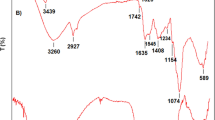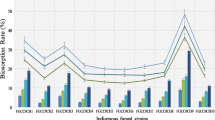Abstract
This study focuses on treatment of landfill leachate in column experiments by immobilized Trametes versicolor on polyurethane foam, collected from Nonthaburi landfill site, Thailand. In this study, glucose was used as a co-substrate. The effect of biomass growth on color removal was observed by immobilizing fungi on polyurethane foam. The same immobilized fungi were used for four cycles of 5 days each to find the reuse of fungi. Leachate was diluted to see the effect of organic loading on color removal. At optimum pH of 4 and in 20 days with 3 g/L of glucose, the fungi could decolorize 78 % and 63 % for 5-times dilution and concentrated leachate, respectively, using immobilized fungi after 4 days initial growth. Fungi could also reduce biological oxygen demand and chemical oxygen demand of 52 % and 42 % (with initial biological oxygen demand and chemical oxygen demand of 48,900 and 96,512 mg/L), respectively, with glucose 3 g/L in concentrate leachate and with 4 days initial immobilization of fungi on polyurethane foam. About 1–6% higher color removal was observed on day 20 with 15 days fungi immobilization initially as compared to 4 days immobilization. Higher removal efficiency was observed for the same leachate after dilution due to reduction in organic loading. Addition of co-substrate enhances significantly removal of color, biological oxygen demand and chemical oxygen demand. Chemical oxygen demand removal reached to 0.6 mg/mg of biomass with the co-substrate. Therefore, white rot fungi can be considered as potentially useful microorganisms in landfill leachate treatment.
Similar content being viewed by others
References
Amaral, P. F. F.; Fernandes, D. L. A.; Tavares, A. P. M.; Xavier, A. B. M. R.; Cammarota, M. C.; Coutinho, J. A. P.; Coelho, M. A. Z., (2004). Decolorization of dyes from textilewastewater by Trametes versicolor. Environ. Tech., 25 (11), 1313–1320 (8 pages).
Benito, G. G.; Miranda, M. P.; Santos, D. R. l., (1997). Decolorization of wastewater from an alcoholic fermentation process with Trametes versicolor. Bioresour. Tech., 61 (1), 33–37 (5 pages).
Boominathan, K.; Reddy, C. A., (1992). Fungal degradation of lignin: Biotechnological applications. In: Arora D. K.; Elander R. P.; Mukherji K. G. (Eds.), Handbook of applied mycology. Dekker, M., New York, 763–782.
Cerniglia, C. E., (1997). Fungal metabolism of polycyclic aromatic hydrocarbons, past, present and future applications in bioremediation. J. Ind. Microbiol. Biot., 19 (5-6), 324–333 (10 pages).
Chiemchaisri, C.; Srisukphun T., (2003). Performance of soil and compost mixture in leachate purification at intermediate cover layer of tropical landfill. In: IWA Conference on Environmental Biotechnology, Advancement on water and wastewater applications in the tropics. December 9-10, Kuala Lumpur, Malaysia.
Daniel, G.; Volc, J.; Kubatova, E., (1994). Pyranose oxidase, a major source of H2O2 during wood degradation by Phanerochaete chrysosporium, Trametes versicolor and Oudemansiella mucida. Appl. Environ. Microbiol., 60 (7), 2524–2532 (9 pages).
Erkurt, E. A.; Ünyayar, A.; Kumbur, H., (2007). Decolorization of synthetic dyes by white rot fungi, involving laccase enzyme in the process. Process Biochem., 42 (10), 1429–1435 (7 pages).
Fu, Y.; Viraraghavan, T., (2001). Fungal decolorization of Dye wastewaters: A review. Bioresource Technol., 79 (3), 251–262 (12 pages).
Kandelbauer, A.; Guebitz, G. M., (2005). Bioremediation for the decolorization of textile Dyes — A review. Enviro. Chem., 269-288 (20 pages).
Kim, S. J.; Shoda, M., (1999). Batch decolorization of molasses by suspended and immobilized fungus of geotrichum Candidum. J. Biosci. Bioeng., 88 (5), 586–589 (4 pages).
Kirk, T. K.; Connors, W. J.; Zeikus, J. C., (1976). Requirement for a growth substrate during lignin decomposition by two wood-rotting fungi. Appl. Environ. Icrobiol., 32(1), 192–194 (3 pages).
Kirk, T. K.; Farrell, R. L., (1987). Enzymatic “combustion” and the microbial degradation of lignin. Annu. Rev Microbiol., 41, 465–505 (41 pages).
Knapp, J. S.; Newby, P. S.; Reece, L. P., (1999). Decolorization of dyes by wood-rotting basidiomycete fungi. Enzyme Microb. Technol., 17 (7), 664–668 (5 pages).
Knapp, J. S.; Zhang, F. M.; Tapley, K. N., (1997). decolourisation of orange II by wood-rotting fungus. J. Chem. Technol. Biot., 69 (3), 289–296 (8 pages).
Lapadatescu, C.; Feron, G.; Vergoignan, C.; Djian, A.; Durand, A.; Bonnarme, P., (1997). Influence of cell immobilization on the production of Benzaldehyde and Benzyl Alcohol by the white-rot fungi bjerkandera adusta, ischnoderma benzoinum and dichomitus squalens. Appl. Microbiol. Biot., 47 (6), 708–714 (7 pages).
Machida, Y.; Nakanashi, T., (1984). purification and properties of pyranose oxidase from Coriolus versicolor. Agric Biol Chem., 48 (10), 2463–2470 (8 pages).
Martin, C.; Manzanares, A., (1994). A study of decolorization of straw soda pulping effluent by Tramestes versicolor. Bioresource Technol., 47 (3), 209–214 (6 pages).
Mehna, A., Bajpai, P.; Bajpai, P. K., (1995). Studies on decolorization of effluent from a small pulp mill utilizing agri-residues with Trametes versicolor. Enzyme Microb. Technol., 17 (1), 18–22 (5 pages).
Nakamura, Y; Mtui, G. S.; Tatsuro, S.; Masaaki, K., (1999). Lignin-degrading enzyme production by Bjerkandera adusta immobilized on polyurethane foam. J. Biosci. Bioeng., 88 (1), 41–47 (7 pages).
Nilsson, I.; Moller, A.; Mattiasson, B.; Trubindamayugi, M. S. T.; Welander, U., (2006). Decolorization of synthetic and real textile wastewater by the use of white-rot fungi. Enzyme Microb. Tech., 38(1–2), 94–100 (7 pages).
Paszczynski, A.; Crawford, R. L., (1995). Potential for bioremediation of xenobiotic compounds by the white rot fungus Phanerochaete chrysosporium. Biotech. Progr., 11 (4), 368–379 (12 pages).
Pointing, S. B., (2001). Feasibility of bioremediation by white rot fungi. Appl. Microbiol. Biotech., 57 (7), 20–33 (14 pages).
PCD, (2005). Pollution Control Department, State of Thailand’s Pollution, http://www.pcd.go.th/public/report45.pdf
Reddy, A., (1995). The potential for white-rot fungi in the treatment of pollutants. Curr. Opin. Biotech., 6 (3), 320–328 (9 pages).
Sathiya Moorthi, P.; Periyar Selvam, S.; Sasikalaveni, A.; Murugesan, K.; Kalaichelvan, P. T., (2007). Decolorization of textile dyes and their effluents using white rot fungi. Af. J. Biotech., 6 (4), 424–429 (6 pages).
Selvam, K.; Swaminathan, K.; Myung, H. S.; Keon-Sang, Ch., (2002). Biological treatment of a pulp and paper industry effluent by Fomes lividus and Trametes versicolor. World J. Microbiol. Biotech., 18 (6), 523–526 (4 pages).
Shah, V.; Nerud, F., (2002). Lignin degrading system of white- rot fungi and its exploitation for dye decolorization. Can. J. Microbiol., 48 (10), 857–870 (14 pages).
SMEW, (1998). Standard Methods for the Examination of Water, 20th. Ed. APHA, AWWA and WEF, Washington, DC.
Swamy, J.; Ramsay, J. A., (1999). Effect of Mn2+ and ammonium concentration on laccase and manganese peroxidase production and amaranth decoloration by trametes versicolor. Appl. Microbiol. Biotech., 51 (3), 391–396 (6 pages).
Wu, J.; Xiao, Ya-Zhong,; Yu, Han-Qing, (2005). Degradation of lignin in pulp mill wastewaters by white rot fungi on biofilm. Bioresour. Tech., 96 (12), 1357–1363 (7 pages).
USEPA, (2007). Summary of the EPA municipal solid waste program.U.S. Environmental Protection Agency. http://www.epa.gov/reg3wcmd/solidwastesummary.htm.
Author information
Authors and Affiliations
Corresponding author
Rights and permissions
About this article
Cite this article
Saetang, J., Babel, S. Effect of leachate loading rate and incubation period on the treatment efficiency by T. versicolor immobilized on foam cubes. Int. J. Environ. Sci. Technol. 6, 457–466 (2009). https://doi.org/10.1007/BF03326085
Received:
Revised:
Accepted:
Published:
Issue Date:
DOI: https://doi.org/10.1007/BF03326085




